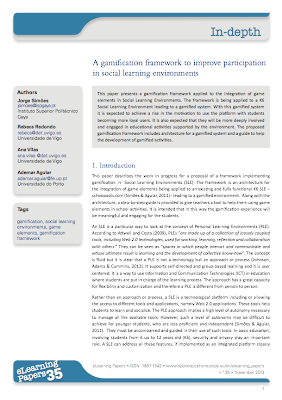Anúncio de um colóquio sobre perspetivas críticas na aplicação de gamification no contexto de estudos empresariais (a tradução pode ser discutível).
Para além do anúncio, vale a pena ler o resumo que é feito sobre a origem e evolução do conceito de gamification como pontos de partida para as perspetivas críticas pretendidas quando ao seu futuro. Os organizadores do colóquio aparentam integrar a corrente dos investigadores sobre o tema da gamification que são oriundos da área do marketing.
Eis o anúncio, tal como chegou:
The theme for this colloquium is critical perspectives on gamification within a context of business studies. It is arranged by Peter Zackariasson, Mikolaj Dymek and Johan Hagberg, and is hosted by University of Gothenburg, School of Business, Economics and Law at the 22nd of November, 2013.
Purportedly coined already as early as 2002 by game developer Nick Pelling, the notion of “gamification” has only gained attention during the last couple of years. Without a paradigmatic definition, a common and tentative viewpoint is that gamification involves the use of game mechanics in “non-game” contexts. Although lacking in stringency this perspective has spawned a global gamification frenzy. A Google Trends query indicates a dramatic surge in popularity at the end of 2010, and interest continues its growth to this date. In 2011 it was termed the hottest digital trend at the immensely influential SXSW festival. Exceptionally popular presentations at the prominent TED Conferences by gamificiation gurus such as Gabe Zichermann, Jane McGonigal, Tom Chatfield and others, have inspired a plethora of software applications, services, campaigns, products and communication strategies that all claim to be part of the gamification movement. These gamification applications have been implemented in an impressing range of fields ranging from weight loss, education, journalism, loyalty programmes through marketing campaigns, exercising, language learning to social networks and corporate intranets. More specifically within a business context efforts have been made within marketing, project management, education, internal communication, health care and human resource management.
The gamification trend has primarily been picked up by the IT industry – often entrepreneurial Internet startups predominantly outside the sphere of the traditional video game industry. A trailblazer in this context has been the immensely successful case of Foursquare – a location-based social network for smartphone users. Using game mechanics Foursquare has during less than four years motivated over 30 million users to “check in” in millions of places around the world. This gamification implementation has generated one of the world’s most comprehensive, and most updated, local commerce directory. Unlike other local services (Yelp, Google Local, Qype, etc.) ratings and recommendations are not based on anonymous voting scores (which can easily be manipulated), but on real check ins, i.e. consumer movements verified by GPS functionality and Foursquare app. However, lately Foursquare has been heavily criticised in media for not generating revenues, floundering popularity and that its business model does not offer easy “monetisation” as advertisements and paid listings would corrupt the neutrality of Foursquare’s recommendations.
As the Foursquare service is being developed into a less gamified interface, critical voices are being raised that this vindicates the end of the entire gamification trend. A trend that was more about hyperbole, gamification gurus and catchy slogans, than it was about expanding the realm of the game medium. Critics have accused gamification implementations to be superficial and excessively uniform based on points, badges and leaderboards, so-called “badgification”. Not only is the gamification concept being questioned by (IT) industry professionals, but game developers and game theorists are heavily criticising the notion as well. Large parts of the (hardcore) gamer community have never really embraced the gamification trend since it indirectly posits game development outside of their domain (“non-game” contexts).
Foursquare, the poster child of the gamification trend, is at a crossroads. We will use this turning point as a stepping stone for focusing a well-deserved critical perspective on the gamification trend, and particularly applications within a business studies context. Multiple issues are being raised about both practical and theoretical value of gamification in studies of consumers, markets, organizations, or other areas in business studies.
We invite theoretical as well as practical papers, within a business context, on the following topics:
-
Can gamification be stringently defined, separated analytically from “conventional” approaches in business studies?
- What are the theoretical perspectives, from games studies/new media/digital literature studies, on the gamification trend - and how does this influence business studies?
- How do we critically analyse the claims of the gamification acolytes and their numerous easy-digestible “airport” business publications ?
- Critical and empirical analysis of successful, or unsuccessful, cases of gamification in business settings such as marketing, project management, education, internal communication, health care and human resource management
- Empirical accounts of gamification production
- How can the business use of gamification be evaluated?
- Can gamification be analysed using established frameworks within economics such as game theory, behavioural economics, management control systems and others that analyse economic behaviour using notions of rules, rewards and evaluations?
- How does gamification relate to management/organisation theory?
- What are the (business) ethical consequences of gamifying employee or customer activity?
-
In other words: what is the future of gamification in a business setting?
Submit an extended abstract (1000 words), plus a short bio to Peter Zackariasson (peter.zackariasson@handels.gu.se). Deadline for the abstract is August 31.
























